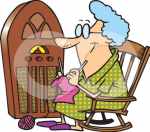First Shortwave Wireless Telephony Broadcasts
With
the rapid development of wireless telephony, due to the invention of the vacuum valve, commercial interests, as well as private
experimenters, began to explore the shortwave region of the communication spectrum more than ever before. In 1925, the first
Trans-Atlantic wireless telephone contact was made on about 5000 kHz, by Mr J. A. Partridge,
In May 1924, the first wireless telephony broadcasts
direct from England to Australia were conducted, and signals were received in Sydney, at the home of Mr Fisk, at Vaucluse.
Beyond doubt, the first international shortwave station was PCJJ, with its experimental
broadcasts in the “30 metre band” in 1924, introduced by the late Eddie Startz, in
his ageless Happy Station programme. The previous year of saw the first trans-Atlantic wireless telephone contact on
a frequency of about 3 MHz by Mr J. A. Partridge, using the callsign 2KF, in England.
Here in Australia, tests were
also being conducted in 1923 by the PMG’s Department. In May 1924,
the first wireless telephony broadcasts direct from England to Australia were carried out, and signals were received in Sydney,
at the home of Mr Fiske, in Vaucluse. The Marconi station at Poldhu, Cornwall, carried out tests with a power of 12 kW in
October 1924, "on 52 metres", and these signals were heard in Sydney, New York, and Buenos Aires.
In January 1925, the American station W8XK, at Pittsburgh,
Pennsylvania, "on 65 metres", successfully tested with telephony to Australia, relaying its mediumwave outlet KDKA. Further
tests were heard in July 1925, and good reception was reported throughout eastern Australia at
around 8.05 pm Eastern Australian Standard Time.
An enterprising private experimenter, Mr Ray Allsop, of
Sydney, using the callsign 2RG, relayed the KDKA test broadcasts over the MW station 2BL in Sydney. His own 80 metre amateur
transmissions were being heard all over Europe in 1925. By the end of 1925, there were about 50 shortwave broadcasting stations
operating internationally, and interest in "wireless" was increasing quickly.
Here in Australia, the experimental transmissions from the American stations
were being widely heard. These included 2XAF with 1 kW, early in 1925, and later
upgraded to 20 kW on 40 metres; this was the General Electric Company’s station at Schenectady. Other calls heard from
this station were W2XAD on 26 metres and W2XAW on
15 metres, all relaying the medium wave outlet WGY.
The period from 1925-1930 saw the introduction of
various other American shortwave stations, generally with relays of their mediumwave transmissions.
The prominent ones were
W2XE (relaying WABY at New York), W2XAL (relaying WLW),
and W6XBE (San Francisco). Some of these experimental shortwave broadcasters were
the forerunners of the OWI (Office of War Information) stations, which in turn developed into the Voice of America. Many of
these stations arranged special tests for listeners here in Australia, and were generally well received.
The higher powered Russian transmitter located at Khabarovsk, with the callsign RFW
using “”66 metres”” was another station that was being widely heard in Australia with good signals.
It was most often reported during the evening hours, around the years 1925/1926.

